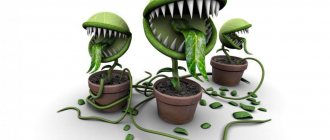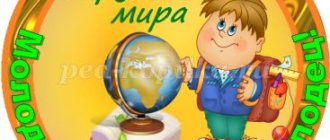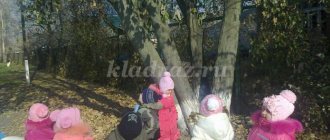Card index of conversations
2. Tell children about the health benefits of fruits for children and adults.
3. Ask what fruits parents buy for their children, remind them that in order to be strong and healthy, they must eat fresh fruits
4.Game “What did autumn give us - did she put it in the basket?”
"I live in a big city"
Target. To form children's ideas about environmental factors in a big city that affect human health (noise, pollution, heavy traffic flows, large numbers of people, advertising). Introduce the rules of safe behavior on city streets.
Preliminary work. While walking with your parents, watch the traffic on the street. Pay attention to the contamination of snow near highways, to emissions from the pipes of boiler houses, industrial enterprises, and thermal power plants.
Progress of the lesson:
1. Involve children in drawing up an image of a big city street on a magnetic board using subject pictures. Discuss what buildings are on this street.
2. Invite children to listen to an audio recording of city sounds, name familiar sources of noise, and then place their images on a magnetic board.
3. Refer to the children’s experience - show them a transparent container with cotton pads that the children brought after observing the condition of green spaces near roads; collective children's drawings, which, based on observations, reflect the state of snow near roads and parking lots.
4. Introduce children to other sources of pollution in nature (boiler houses, thermal power plants, industrial enterprises). Ask them to place images of these objects on a magnetic board.
5. Offer to watch a video recorded on a crowded street. Draw the children's attention to heavy traffic and a large number of pedestrians. Offer to make assumptions about where people walking on the street are heading. Lead children to the conclusion about the dependence of people’s psychological state and behavior on various activities and concerns.
6. Explain to children the features of a big city - the possible territorial remoteness of objects that are significant to a person, the need to use transport to move around the city, inevitable contact with a large number of people on the streets, and transport, in stores, a large amount of advertising, etc.
7. Introduce children to the rules of safe behavior on the streets of a big city: cross the street at a pedestrian crossing, stay close to their parents, avoid crowds.
“All kids need to know how to walk down the street”
Goal: To consolidate the rules of behavior on the street: traffic rules, the concept of a traffic light and its purpose. Teach the rules of safe behavior on the streets. Contribute to the formation of a culture of verbal communication in transport.
Ecological conversations with preschool children
Ecological conversations with preschool children
Currently, due to the deterioration of the environment, there is a need to increase environmental awareness of every person, regardless of age. In this regard, the country is actively creating a system of continuous environmental education for the population. The initial link of this system is a preschool institution, where the foundations of environmental knowledge are laid. Teachers resort to various means, forms and methods with which they can effectively solve the problems of environmental education.
Conversation is one of the important forms of activity of the teacher and students, as it represents great opportunities for the environmental education of preschoolers. A conversation brings the child closer to the teacher, makes it possible to unobtrusively and imperceptibly exert an educational influence: after all, education, as V.A. noted. Sukhomlinsky, this is “constant spiritual communication between teacher and child.” Conversation is widely used in any type of activity of the teacher and children. To carry it out, you can use a whole range of methods and techniques: games, dramatization, discussion of situations, excerpts from the works of writers, folklore materials, music, reproductions of paintings. All this contributes not only to the formation of environmental knowledge, but also to the formation of a personal position, the education of emotions and feelings.
Environmental conversations should be held throughout the year. So, in the fall, we talk with children on the topics: “Why trees undress in the fall”, “Is autumn good or bad”, “Why do animals change their coats”, “How do plants live in winter”, “How do animals prepare for winter”. We use active and didactic games: “The Kite and the Hen”, “Run to the Named Tree”, “What Has Changed?”, “Find a Pair”, “Whose House?” and etc.
In the book corner we display scientific and fiction literature for children. We introduce preschoolers to fiction, according to the long-term environmental plan. Parents are also involved in preparing for the upcoming conversation. To do this, in the “Parents Corner” or in a group chat we post a list of literature for home reading with children, recommendations and articles on the topic of conversation and issues of environmental education for preschoolers. Children and parents begin to prepare for the conversation “Feed the birds in winter” in advance: we collect seeds and fruits of plants and create a pantry for winter feeding of birds, which is a real manifestation of care and kindness towards the inhabitants of nature. We conduct a conversation on this topic in December, when winter comes into its own. Children already know that birds that can find food for themselves in the harsh season remain in our area for the winter.
This knowledge is confirmed by observations of sparrows, crows, tits, bullfinches and waxwings on excursions and walks. It turns out how many birds can be seen in nature now? Why did insectivorous and waterfowl fly to warm countries? What do birds eat in winter? What foods do different birds like? We inform you that sparrows love the seeds of herbaceous plants, bullfinches love the seeds of rowan, birch, lilac, and crows and magpies love various refuse. We say that in winter, birds are less picky about food, so some food from our table is suitable for feeding birds. So what should you feed? Tits prefer pieces of unsalted lard and meat, crumbs of white bread, sparrows prefer cereals, seeds, bread crumbs, bullfinches prefer watermelon, pumpkin and sunflower seeds. Let's get acquainted with the rules of feeding birds.
At the end of the conversation, we make a decision with the children: together with their parents, make and hang feeders on the territory of the kindergarten and in the courtyards of their houses. Feeders are usually made from waste material. In conversation we use poems that touch the child’s soul and find an emotional response in his soul. As well as riddles that enliven the conversation, maintain the interest of students, activate cognitive activity, and develop the ability to observe and understand nature.
Conversation “What have you seen unusual in nature?” We carry out in autumn, and winter, and spring, and summer. Nature is an inexhaustible source of beauty, secrets and mysteries. Often children in older preschool age lose interest in their immediate natural environment, believing that they will not see anything interesting near them. And talking about the amazing helps them discover new secrets, see the beauty in an ordinary and familiar snowflake, icicle, or snow-covered tree crown. Of course, it is easier to have such a conversation in spring and summer, when the green leaves of trees and bushes are blooming, when bird voices are heard everywhere, when the beauty of nature - its sounds, colors - does not leave anyone indifferent. It is more difficult to do this in winter, when there are few objects for children to observe, but it is easier to pay attention to their shapes, lines and colors - against the backdrop of snow-white snow.
In preparation for the winter environmental conversation, we use the possibilities of excursions and walks to the forest park, to the vegetable garden (located on the territory of the children's institution). We draw children's attention to dry tall stems rising above the snow cover, the shape and color of clouds in the sky, shadows in the snow, crowns of bushes and trees, snowdrifts, the color of birds, etc. Together with the children, we collect winter bouquets of dry herbs, which we place in a group. They are no worse than bouquets of flowering herbs in summer. During a snowfall, we make riddles about snowflakes, and look at the falling snowflakes against the bright background of children's clothes - we are surprised at their diversity.
Thus, we are gradually preparing the environment for discoveries of the unusual in the ordinary. And works of folklore, in particular, riddles, proverbs, and signs that tell about a natural object or phenomenon in an allegorical form, help children to discover them in many ways. Here, for example, are the signs we introduce children to in the winter:
The pigeons cooed - the weather will be good.
The cat curled up in a ball - in the cold.
Crows fly and circle - it means frost.
The natural world is fraught with many beautiful and amazing things for the perception and knowledge of a small person. And environmental conversation creates a certain mood in the children for their discoveries and research. We choose topics for conversations and problems so that they arouse interest among children. They awakened the desire to discover and study their natural environment, to observe various phenomena, patterns and connections in it. And this is a condition for children to become good stewards of their land in the future, taking into account knowledge of environmental relationships in their activities and behavior.
Literature:
1. A.I. Ivanova. Living ecology. – M.: Creative, 2006
2. O. A. Voronkevich. Welcome to ecology. St. Petersburg: Childhood - press, 2002
3. L. P. Simonova. Keys from nature, or ethical conversations on ecology. – M.: “Agar”, 1998.





